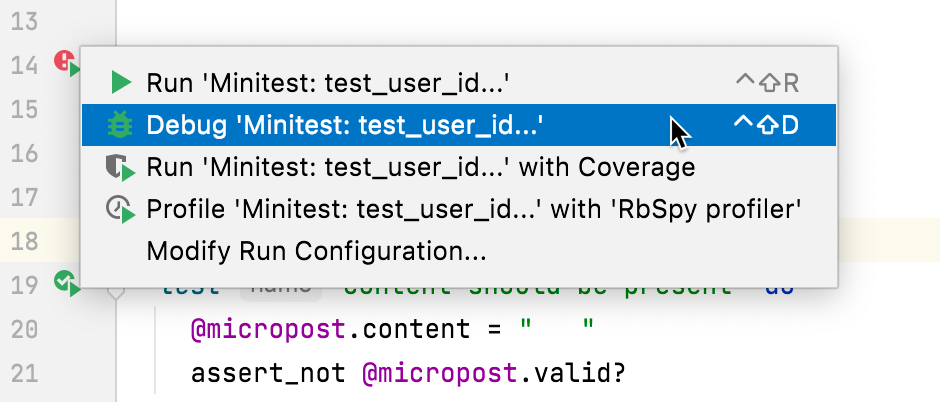Run tests
Run the selected test or test folder:
Stop the current test session:
If your tests don't require any specific actions before start, and you don't want to configure additional options, such as code coverage, you can run them by using the following options:
Place the caret at the test class to run all tests in that class, or at the test method, and press . Alternatively, click the
gutter icon next to the test class or test method and select Run '<test name>' from the list.
The gutter icon changes depending on the state of your test:
The
gutter icon marks a set of tests.
The
gutter icon marks new tests.
The
gutter icon marks successful tests.
The
gutter icon marks failed tests.

You can run all tests in one or several files or a folder at once. Select the required folder or test files and press . Alternatively, call the context menu and select Run 'All tests in <directory name>' or Run 'All specs in <directory name>' depending on the testing framework in use.

When you run a test, RubyMine creates a temporary run configuration. You can save temporary run configurations, change their settings (for example, pass task arguments, specify environment variables, and so on) , share them with other members of your team.
Create a new run configuration or save a temporary one.
Use the Run widget on the main toolbar to select the configuration you want to run.
Click
or press .

tip
To preserve the tab of a run configuration even if you execute another run configuration, you may pin it.
After RubyMine finishes running your tests, it shows the results in the Run tool window on the tab for that run configuration. For more information about analyzing test results, refer to Explore test results.
To run tests using a Rake task, do the following:
Go to Tools | Run Rake Task .
In the invoked popup, start typing the name of a Rake task that runs tests, for example,
rake testorrake spec:controllers.Select the desired Rake task from the list and press .
tip
RubyMine automatically creates the Rake run configurations for running the Minitest and RSpec tests in Rails applications - test and spec. Learn how to run code using configurations from Run tests using a predefined configuration.
When you want to check that your changes wouldn't break the code before pushing them, you can do that by running tests as commit checks.
note
Press to open the Commit tool window and click Show Commit Options
.
Under the Commit Checks menu, next to the Run Tests option, click Choose configuration and select which configuration you want to run.

After you have set up the test configuration, the specified tests will run every time you make a commit.

Use the following options on the Run toolbar of the tab for the run configuration:
Click
or press to terminate the process immediately.

Right-click a test on the tab for the run configuration in the Run tool window and select Run 'test name'.
Click
on the Run toolbar or press to rerun all tests in a session.
Click
on the Run toolbar to rerun only failed tests.
Hold and click
to choose whether you want to Run the failed tests again or Debug them.
In RubyMine, you can enable the autotest-like runner: any test in the current run configuration restarts automatically after you change the related source code.
Click
Rerun Automatically on the test results toolbar to enable the autotest-like runner.

If you don't know why a test fails, you can debug it.
In the editor, click the gutter on the line where you want to set a breakpoint.
There are different types of breakpoints that you can use depending on where you want to suspend the program. For more information, refer to Breakpoints.
Right-click the
gutter icon next to the failed test and select Debug 'test name'.

The test will rerun in debug mode. After that, the test will be suspended, allowing you to examine its current state.
You can step through the test to analyze its execution in detail.